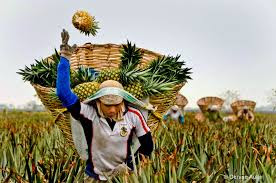ORGANIC PINEAPPLE PRODUCTION
(a) Organic pineapple cultivation
Characteristics of pineapples
. Pineapples are self-sterile and mostly free of seed
. Pineapple can survive long dry periods
. Pineapple can survive long dry periods
.Pineapples are eaten fresh or processed into dried fruits, juice and as canned fruits
Natural requirements of pineapple
. Temperatures of between 22 centigrade and 28 centigrade
. Pineapple is cultivated from sea level to 2100
. About 1000 mm of rainfall well distributed
. Sandy loam soil with high organic content
Land preparation
. Prepare land properly for proper root development and good yield
. Clear perennial weed by repeated deep cultivation during dry season
. Uproot weed, allow them to dry, harrow into strips and burn them
. Plough to a depth of 45 cm, or if using hand digging, dig as deep as possible.
. After ploughing, use a disc harrow to produce a fine tilth
Planting
. Strip off basal leaves of the seedlings
. Ensure that the "heart" of the plant is above soil level is avoid rotting
.Have the largest number of plants per unit area as is practical.
. The double-row system is the recommended system of planting.
. Store planting materials for up to three months then plant in loose friable dry or pre-irrigated soil
.Plant healthy, large shoots to ensure uniform crop
. Lay a ground cover of mulch or polythene for protection from weeds and the extra heat it seems to absorb.
Spacing/seed depth
. For mono-cropping a plant population of 70,000 to 100,000 plants is recommended
. Plant double rows 60 cm apart, 90 cm between the double rows, and 30 cm between plants.
.Under rain fed conditions spacing between double rows is increased to double rows 60 cm
Weeding
. When inter-cropped with legumes, weed only once.
. Weeding will not be necessary once the crop covers the soil.
. Hand pulling of weeds is recommended after the first weeding
. Once the first crop is harvested remove all slips and unwanted suckers
Mulching
.Use green manure and organic refuse as mulch
.Mulching with black polythene increases yields by 50% and gives better quality fruits.
. Lay the mulch between the two double rows before planting.
Pest/Disease control
. The two main insects are the Ant and the Mealybug
. Initial control should be directed against the ants to ensure success.
.Ants are controlled by applying baits
Rotation
. Follow crop rotation allowing several years between pineapples crops on the same land.
.Some crops usually included in rotation with pineapples are groundnuts, beans,rice and vegetables.
. Green manure plants like cow pea can be grown and incorporated into the soil prior to planting pineapples.
(b) Harvesting
Assessing maturity
. Fruit maturity is evaluated on eye flatness and skin yellowing.
.Observe the flesh condition to assess fruit maturity.
. Take random samples and slice horizontally at point of largest diameter.
. Minimum sugar content (Brix) should be 10% at the top and 12% at the bottom of the manure pineapple.
Harvesting
. After picking pineapple, does not ripen or improve in quality
. Pineapple is hand harvested with the pickers being directed as to the stage of ripeness required.
. Pineapple is harvested by breaking the stalk a few centimeters below the fruit.
(c) Post Harvesting
Storage
. Packing the fruit is done either in the field or at a central packing shed.
To avoid loss of quality, do not use polythene bags for packing and transporting the fruit.
. Place the fruits in fields crates for transport to the packing shed.
.Undersized, oversize, overripe, under ripe, damaged, bruised, insect, and fungal infested fruits should be rejected.
Processing of dried pineapple
. At the factory, the top and bottom of the pineapples are cut off
.The fruit is washed and weighed, then peeled, sliced and weighed again.
. The slices are chopped into smaller pieces and dried.
Marketing
.The dried fruit is packed, weighed and sealed.
. Dried pineapples are sold locally and abroad











